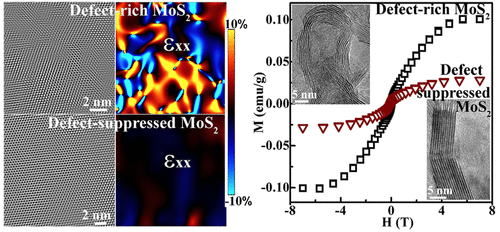当前位置:
X-MOL 学术
›
ACS Appl. Nano Mater.
›
论文详情
Our official English website, www.x-mol.net, welcomes your
feedback! (Note: you will need to create a separate account there.)
Tailoring Magnetically Active Defect Sites in MoS2 Nanosheets for Spintronics Applications
ACS Applied Nano Materials ( IF 5.3 ) Pub Date : 2020-01-10 , DOI: 10.1021/acsanm.9b02121 Rohini Sanikop 1 , C. Sudakar 1
ACS Applied Nano Materials ( IF 5.3 ) Pub Date : 2020-01-10 , DOI: 10.1021/acsanm.9b02121 Rohini Sanikop 1 , C. Sudakar 1
Affiliation

|
We show that it is possible to tune the magnetic properties in MoS2 without any intentional magnetic dopants but by simply controlling the magnetically active defect sites. The layer thickness and defect-density-controlled MoS2 (2H-phase) nanosheets are obtained by annealing a wet-chemical precursor from 500 to 900 °C. High-resolution transmission electron microscopy images show the presence of planar and edge defects arising from abruptly terminating edges, bends, tears, and folding of nanosheets. In addition, Mo5+ and sulfur vacancy point defects are predominant, as evidenced from the electron paramagnetic resonance and X-ray photoelectron spectra. Nanosheets gradually become more crystalline and devoid of defects upon annealing, with MoS2 (900 °C) becoming >70% defect-free. The interlayer spacing decreases monotonically from ∼6.351 to 6.231 Å with annealing; however, the lattice parameter a increases from 3.107 to 3.172 Å. These structural changes induce a large local strain (∼9%) in MoS2 (500 °C) nanosheets compared to the small strain (∼3%) present in MoS2 (900 °C). Raman spectroscopy further manifests control on the defect density, with the intensity ratio of the defect-induced LA(M) mode (∼227 cm–1) relative to the E2g1 and A1g modes decreasing monotonically with the annealing temperature. We demonstrate that magnetically active defect sites can be tuned to enhance the ferromagnetism. Magnetization (at 5 K) systematically varies with 1 order higher MS (=0.10 emu/g) found in MoS2 (500 °C) nanosheets compared to MoS2 (900 °C). Interestingly, temperature-dependent magnetization shows a ferromagnetic-like transition around 120 K, which becomes more pronounced in defect-rich MoS2. The ferromagnetic interaction is more likely due to a bound magnetic polaron made up of a spin 1/2 Mo5+ ion with trapped carriers present at the sulfur vacancies. These findings open a new way of exploring spintronic devices such as spin-field-effect switches, spin valves, magnetic sensors, and ultrathin high-density data storage devices using MoS2 2D nanosheets by controlling magnetically active defect sites.
中文翻译:

在用于自旋电子学的MoS 2纳米片中定制磁性活性缺陷位点
我们表明,有可能在没有任何故意的磁性掺杂剂的情况下,通过简单地控制磁活性缺陷位点来调整MoS 2中的磁性能。通过将湿化学前体从500到900°C进行退火,可以获得层厚和缺陷密度受控的MoS 2(2H相)纳米片。高分辨率透射电子显微镜图像显示,由于纳米片的突然终止边缘,弯曲,撕裂和折叠而引起的平面和边缘缺陷的存在。另外,从电子顺磁共振和X射线光电子能谱证明,Mo 5+和硫的空位点缺陷是主要的。使用MoS 2时,纳米片逐渐变得更加结晶,并且在退火后没有缺陷(900°C)达到> 70%的无缺陷。随着退火,层间间距从约6.351到6.231Å单调减小;但是,晶格参数a从3.107增大到3.172Å。与MoS 2(900°C)中存在的小应变(〜3%)相比,这些结构变化在MoS 2(500°C)纳米片中引起较大的局部应变(〜9%)。拉曼光谱进一步证明了缺陷密度的控制,缺陷诱导的LA(M)模式的强度比(〜227 cm –1)相对于E 2g 1和A 1g模态随退火温度单调降低。我们证明,可以调整磁性活动缺陷部位以增强铁磁性。与MoS 2(900°C)相比,在MoS 2(500°C)纳米片中发现的磁化强度(在5 K时)系统变化,其M S(= 0.10 emu / g)高1个数量级。有趣的是,随温度变化的磁化强度在120 K附近显示出类似铁磁的转变,这种转变在富含缺陷的MoS 2中更为明显。铁磁相互作用是更可能是由于自旋的由一个束缚磁极化子1 / 2的Mo 5+离子与硫空位处存在的被捕获的载流子结合。这些发现为控制自旋电子器件(如自旋场效应开关,自旋阀,磁传感器和超薄高密度数据存储设备)打开了一种新的途径,该方法使用MoS 2 2D纳米片通过控制磁活动缺陷部位来实现。
更新日期:2020-01-10
中文翻译:

在用于自旋电子学的MoS 2纳米片中定制磁性活性缺陷位点
我们表明,有可能在没有任何故意的磁性掺杂剂的情况下,通过简单地控制磁活性缺陷位点来调整MoS 2中的磁性能。通过将湿化学前体从500到900°C进行退火,可以获得层厚和缺陷密度受控的MoS 2(2H相)纳米片。高分辨率透射电子显微镜图像显示,由于纳米片的突然终止边缘,弯曲,撕裂和折叠而引起的平面和边缘缺陷的存在。另外,从电子顺磁共振和X射线光电子能谱证明,Mo 5+和硫的空位点缺陷是主要的。使用MoS 2时,纳米片逐渐变得更加结晶,并且在退火后没有缺陷(900°C)达到> 70%的无缺陷。随着退火,层间间距从约6.351到6.231Å单调减小;但是,晶格参数a从3.107增大到3.172Å。与MoS 2(900°C)中存在的小应变(〜3%)相比,这些结构变化在MoS 2(500°C)纳米片中引起较大的局部应变(〜9%)。拉曼光谱进一步证明了缺陷密度的控制,缺陷诱导的LA(M)模式的强度比(〜227 cm –1)相对于E 2g 1和A 1g模态随退火温度单调降低。我们证明,可以调整磁性活动缺陷部位以增强铁磁性。与MoS 2(900°C)相比,在MoS 2(500°C)纳米片中发现的磁化强度(在5 K时)系统变化,其M S(= 0.10 emu / g)高1个数量级。有趣的是,随温度变化的磁化强度在120 K附近显示出类似铁磁的转变,这种转变在富含缺陷的MoS 2中更为明显。铁磁相互作用是更可能是由于自旋的由一个束缚磁极化子1 / 2的Mo 5+离子与硫空位处存在的被捕获的载流子结合。这些发现为控制自旋电子器件(如自旋场效应开关,自旋阀,磁传感器和超薄高密度数据存储设备)打开了一种新的途径,该方法使用MoS 2 2D纳米片通过控制磁活动缺陷部位来实现。









































 京公网安备 11010802027423号
京公网安备 11010802027423号